
Many new cars are being manufactured without traditional dipsticks for checking engine oil levels, leaving some drivers perplexed and relying on electronic sensors. This trend, driven by cost savings and engineering advancements, raises questions about reliability and maintenance accessibility.
The familiar ritual of popping the hood and pulling out the dipstick to check the engine oil level is becoming a thing of the past for many new car owners. Automakers are increasingly omitting this simple, yet vital, piece of equipment from their vehicles, opting instead for electronic sensors and dashboard readouts. While this move is touted as a technological advancement, it has sparked concerns among car enthusiasts and mechanics alike, who worry about the reliability of these systems and the potential for increased maintenance costs.
The shift away from dipsticks is primarily motivated by two factors: cost savings and design efficiency. According to the original Yahoo Autos report, manufacturers can save money by eliminating the dipstick tube and the dipstick itself, streamlining the engine design and reducing the number of parts required. “It’s all about cost,” said an anonymous source quoted in the Yahoo article, familiar with automotive manufacturing processes. “Every little piece adds up when you’re making millions of cars.”
Furthermore, the move aligns with the industry’s push towards more complex and technologically advanced vehicles. Modern engines are designed to operate with greater precision and efficiency, and electronic sensors are seen as a more accurate way to monitor oil levels and other vital engine parameters. These sensors provide real-time data to the vehicle’s computer, which can then alert the driver to any potential problems.
However, the reliance on electronic sensors is not without its drawbacks. Unlike a dipstick, which provides a direct and tangible measurement of the oil level, electronic sensors are susceptible to malfunctions and inaccuracies. A faulty sensor could provide a false reading, leading the driver to either overfill or underfill the engine with oil, both of which can have serious consequences. Overfilling the engine can cause aeration of the oil, reducing its lubricating properties and potentially damaging engine components. Underfilling the engine, on the other hand, can lead to increased wear and tear, overheating, and ultimately, engine failure.
Moreover, the absence of a dipstick makes it more difficult for car owners to perform basic maintenance tasks themselves. Checking the oil level with a dipstick is a simple and straightforward procedure that most drivers can easily perform. However, relying on electronic sensors requires the driver to trust the accuracy of the system and to be familiar with the vehicle’s dashboard display and warning lights. This can be particularly challenging for older drivers or those who are not as comfortable with technology.
Mechanics also express concern about the lack of a physical dipstick, as it limits their ability to diagnose engine problems. A dipstick allows a mechanic to visually inspect the oil for signs of contamination, such as metal shavings or coolant, which can indicate serious internal damage. Without a dipstick, mechanics must rely solely on electronic data and other diagnostic tools, which may not always provide a complete picture of the engine’s condition.
“It’s frustrating,” said a mechanic interviewed for the Yahoo article. “You used to be able to pull the dipstick and get a pretty good idea of what was going on inside the engine. Now, you’re relying on a sensor that could be wrong.”
The move away from dipsticks also raises questions about the long-term reliability of modern engines. While electronic sensors are designed to be durable and reliable, they are still susceptible to failure over time. As vehicles age, the sensors may become less accurate, leading to inaccurate oil level readings and potential engine damage. Furthermore, the cost of replacing a faulty sensor can be significant, adding to the overall cost of vehicle ownership.
Despite these concerns, automakers argue that electronic oil level monitoring systems are more accurate and reliable than traditional dipsticks. They claim that these systems are designed to provide early warning of any potential problems, allowing drivers to take corrective action before serious damage occurs. Furthermore, they point out that modern synthetic oils are designed to last longer and require less frequent changes, reducing the need for frequent oil level checks.
However, critics argue that these arguments are not entirely convincing. They point out that even with synthetic oils, it is still important to check the oil level regularly, especially in older vehicles or those that are driven under harsh conditions. Furthermore, they argue that the cost savings associated with eliminating the dipstick are minimal compared to the potential cost of engine damage caused by a faulty sensor.
The trend of eliminating dipsticks is likely to continue as automakers continue to push towards more technologically advanced vehicles. However, it is important for car owners to be aware of the potential risks and to take steps to protect their investment. This includes familiarizing themselves with the vehicle’s oil level monitoring system, checking the oil level regularly (if possible), and seeking professional help if they suspect any problems.
The disappearance of the dipstick is symptomatic of a larger trend in the automotive industry: the increasing reliance on technology and the decreasing emphasis on mechanical simplicity. While technology can undoubtedly improve vehicle performance and efficiency, it is important to remember that it is not a substitute for good old-fashioned maintenance and common sense. Car owners should take the time to understand their vehicles and to perform basic maintenance tasks themselves whenever possible. This will not only save them money but also help to ensure the long-term reliability and performance of their vehicles.
Several automakers have already adopted this approach, including BMW, Audi, and Mercedes-Benz. These manufacturers argue that their electronic oil monitoring systems are more accurate and reliable than traditional dipsticks. However, the trend is not limited to luxury brands. More mainstream manufacturers, such as Honda and Toyota, are also beginning to phase out dipsticks in some of their models.
The lack of a dipstick can be particularly problematic for owners who prefer to perform their own oil changes. Without a dipstick, it can be difficult to accurately measure the amount of oil that needs to be added to the engine. This can lead to overfilling or underfilling, both of which can damage the engine.
In some cases, automakers have provided alternative methods for checking the oil level. For example, some vehicles have a sight glass on the side of the engine that allows the owner to visually inspect the oil level. However, these alternatives are not always as convenient or accurate as a traditional dipstick.
The debate over dipsticks highlights the ongoing tension between technology and tradition in the automotive industry. While technology can offer many benefits, it is important to ensure that it does not come at the expense of reliability and maintainability. Car owners should carefully consider the pros and cons of electronic oil monitoring systems before purchasing a new vehicle.
Ultimately, the decision of whether or not to include a dipstick in a new vehicle is up to the automaker. However, it is important for automakers to be transparent with consumers about this change and to provide them with clear and accurate information about how to monitor their engine oil level. Car owners should also take the time to educate themselves about their vehicles and to perform regular maintenance to ensure their long-term reliability. The move away from the traditional dipstick signals a fundamental shift in how drivers interact with their vehicles and how they perceive basic maintenance.
The change also requires a re-evaluation of best practices for both drivers and mechanics. Drivers need to become more comfortable with relying on electronic systems, understanding their limitations, and responding appropriately to warnings. Mechanics need to adapt their diagnostic techniques to account for the absence of a physical dipstick, relying more heavily on electronic diagnostic tools and their understanding of engine management systems.
Moreover, this trend highlights the increasing complexity of modern vehicles and the need for specialized knowledge to maintain them. As cars become more technologically advanced, the barrier to entry for DIY maintenance increases, potentially leading to a greater reliance on professional mechanics. This shift could have significant implications for the automotive aftermarket, as independent repair shops may need to invest in new equipment and training to keep pace with the changing technology.
The absence of a dipstick also raises ethical considerations for automakers. Some critics argue that by removing this simple and inexpensive device, manufacturers are intentionally making it more difficult for owners to perform their own maintenance, thereby driving more business to dealerships and authorized service centers. While there is no concrete evidence to support this claim, the perception remains that automakers are prioritizing profit over consumer convenience.
Looking ahead, it is likely that the trend of eliminating dipsticks will continue, as automakers strive to further optimize engine design and reduce manufacturing costs. However, it is also possible that some manufacturers may eventually reverse course, recognizing the value of providing consumers with a simple and reliable way to check their engine oil level. In the meantime, car owners should remain vigilant and proactive in maintaining their vehicles, regardless of whether they have a dipstick or not.
The disappearing dipstick is more than just a minor inconvenience; it’s a reflection of the evolving relationship between humans and machines in the automotive age. As cars become increasingly autonomous and self-monitoring, the role of the driver is gradually shifting from active participant to passive observer. While this shift may offer certain benefits, it also carries the risk of disconnecting drivers from the fundamental mechanics of their vehicles. By understanding the implications of this trend, car owners can make informed decisions about their vehicle purchases and maintenance practices, ensuring that they remain in control of their automotive destiny.
This also puts a spotlight on the need for enhanced consumer education. Automakers and automotive publications should provide clear and comprehensive information on how to properly monitor engine oil levels in vehicles without dipsticks. This information should include details on how to interpret electronic readings, identify potential problems, and take appropriate action. Furthermore, training programs for mechanics should be updated to reflect the changing technology and to equip them with the skills necessary to diagnose and repair modern engines effectively.
The discussion around the disappearing dipstick extends beyond just the practical considerations of checking oil levels. It also touches on broader themes of technological advancement, consumer autonomy, and the evolving role of the driver in the modern automotive landscape. As cars become increasingly complex and interconnected, it is important to consider the implications of these changes and to ensure that they are aligned with the best interests of consumers.
The trend also necessitates a critical evaluation of the reliability and accuracy of electronic sensors. While these sensors offer the potential for improved performance and efficiency, they are not infallible. Automakers should invest in rigorous testing and quality control to ensure that these sensors are functioning properly and providing accurate readings. Furthermore, they should provide consumers with clear and transparent information on the limitations of these systems.
The removal of the dipstick also affects the aftermarket industry, particularly the manufacturers of aftermarket dipsticks and related tools. These companies may need to adapt their product offerings to cater to the changing needs of the market, perhaps by developing electronic dipstick alternatives or diagnostic tools specifically designed for vehicles without traditional dipsticks.
The absence of the dipstick has also prompted discussions about the future of car maintenance. With the increasing complexity of modern vehicles, many traditional maintenance tasks are becoming more difficult for DIY enthusiasts. This could lead to a greater reliance on professional mechanics and a shift in the balance of power between automakers and consumers.
The debate surrounding the vanishing dipstick serves as a reminder that technological progress is not always synonymous with improvement. While technology can offer many benefits, it is important to carefully consider the potential drawbacks and to ensure that these advancements are aligned with the needs and expectations of consumers. The humble dipstick, a symbol of simplicity and reliability, may be disappearing from our cars, but the need for vigilance and proactive maintenance remains as important as ever.
Frequently Asked Questions (FAQ)
Q1: Why are new cars being manufactured without dipsticks?
A: Automakers are primarily eliminating dipsticks for cost savings and design efficiency. Removing the dipstick tube and dipstick reduces the number of parts required and streamlines engine design. Additionally, manufacturers are moving towards more technologically advanced vehicles with electronic sensors for monitoring oil levels. As quoted in the Yahoo article, “It’s all about cost… Every little piece adds up when you’re making millions of cars.”
Q2: How do I check my oil level if my car doesn’t have a dipstick?
A: Cars without dipsticks rely on electronic oil level sensors and dashboard readouts. The vehicle’s computer monitors the oil level and alerts the driver through a warning light or message on the instrument panel if the oil level is low. It’s crucial to consult the owner’s manual to understand how to interpret these readings and warnings.
Q3: Are electronic oil level sensors reliable?
A: While automakers claim that electronic oil level monitoring systems are accurate and reliable, they are still susceptible to malfunctions and inaccuracies. A faulty sensor could provide a false reading, leading to either overfilling or underfilling the engine with oil. It is recommended to perform regular maintenance and seek professional help if you suspect any issues with the sensor.
Q4: What are the potential problems associated with relying solely on electronic oil level sensors?
A: The potential problems include:
- Sensor Malfunctions: Sensors can fail, providing inaccurate readings.
- Overfilling or Underfilling: A faulty sensor can lead to incorrect oil levels.
- Difficulty in Diagnosing Engine Problems: Mechanics can’t visually inspect the oil for contamination.
- Long-Term Reliability: Sensors may become less accurate over time as vehicles age.
Q5: Can I still perform my own oil changes if my car doesn’t have a dipstick?
A: Performing oil changes without a dipstick can be more challenging. It can be difficult to accurately measure the amount of oil that needs to be added, potentially leading to overfilling or underfilling. Consult your owner’s manual for specific instructions and consider seeking professional assistance to ensure the oil change is done correctly.









